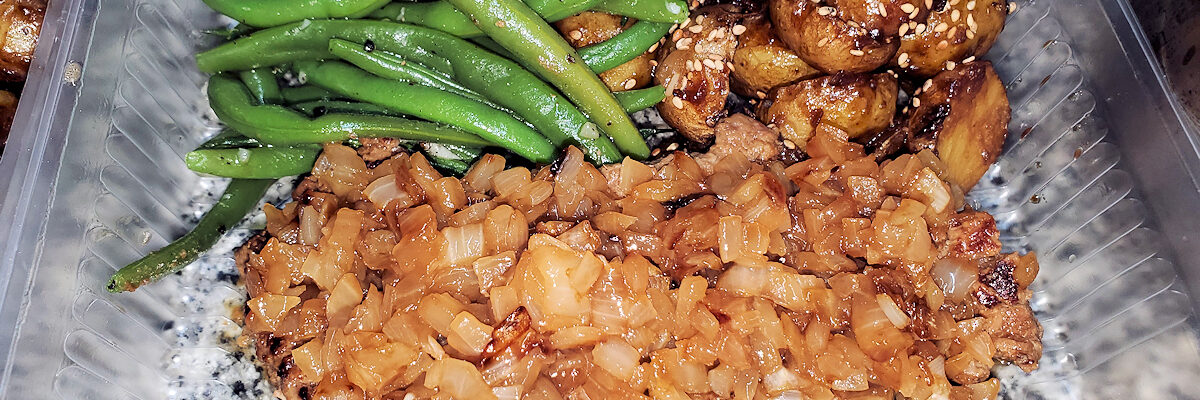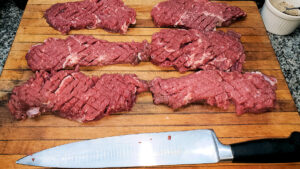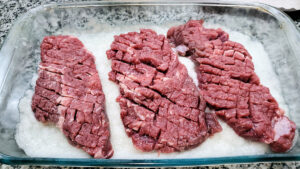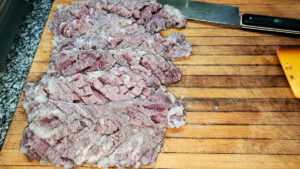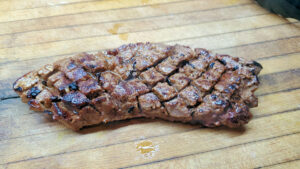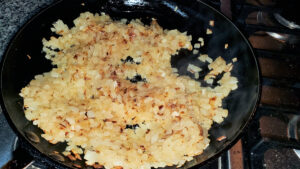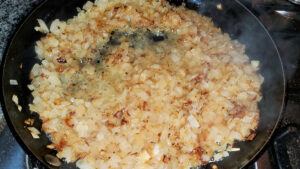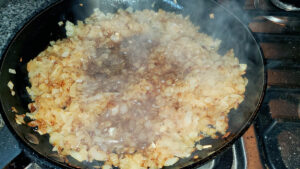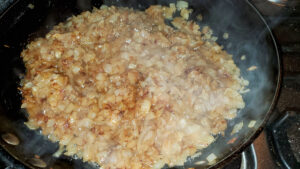Now that we have a full-on kitchen again, we’re back to offering food on the weekends for delivery or pickup. Current plan is to offer an appetizer of some sort, plus two main courses, and at times, a dessert. We’ve got two weekends under our belt so far, and I thought I’d present one of the dishes, which is somewhat unusual. I had mentioned a couple of posts back, with the pasta, crozet, about learning of various foods I’d never heard of while watching a Japanese food anime. This one comes from there too, and a Japanese dish, Chaliapin Steak.
The story behind the steak is that back in 1936, famed bass opera singer Feodor Chaliapin was visiting Tokyo for a series of performances. One night, in the Imperial Hotel, he either complained of a toothache, or lamented that he missed a dish his grandmother used to make of beef with lots of onions, and chef Fukuo Tsutsui took it as a challenge. Perhaps it was both. Perhaps it was neither. Either way, what was served (and apparently still is) at one of the top hotels in Tokyo has become a way of preparing steak that is offered up at “family style restaurants” throughout the area, and even available frozen in supermarkets. Strangely, though, none of the friends I have who’ve been to Tokyo seem to have encountered this steak. Of course, most of them probably spend all their time in ramen and sushi bars….
Now, I probably didn’t need to go for ribeye steaks. The Imperial Hotel uses a tougher cut, the rump steak, as this way of preparing a steak is all about creating tenderness in a piece of meat that may not be as tender to start with. At the same time, I found online people using everything from cheap minute steaks to wagyu sirloin. Something like a rump or ribeye seems like a perfect mid-range steak to use.
Trimmed off the fat.
Pounded them out a little with a meat mallet to start tenderizing and get them to 1 cm thick, a little under ½”.
Cut a crosshatch pattern into them a little more than halfway through the meat.
You’re going to need a lot of onions for this dish. I was making six portions here, and for this part, I used three large onions. I peeled them and pureed them. I put about a third of the puree down in baking dishes and laid the steaks on top of them.
And then covered the steaks with the rest… making sure to rub it all over so the onion puree gets into the cuts. I then set these aside for an hour to tenderize, and infuse the flavor. You have to like onions for this dish. But hey, I called this post steak ‘n onions for a reason.
After an hour, take the steaks out and brush off the majority of the onion puree.
Then salt and pepper it on both sides and sear it quickly in a pan with butter and oil (why both? butter promotes browning, the oil helps prevent burning). Because it’s pounded out so thin, it will cook through to medium rare or medium by the time the surface is caramelized – it literally takes like 3-4 minutes to cook.
Meanwhile… maybe fifteen minutes or so before you take the steaks out of their onion marinade, we’re going to caramelize onions. For those six steaks, I used two onions, finely diced, and cooked them in butter over low heat. I like to do a slow caramelization over the lowest heat my burner will go, so this takes about 15-20 minutes to get to this point.
Deglaze the pan with a splash of white wine or vermouth. Some of the sites recommended mirin, the Japanese sweet rice wine, but a few suggested it makes the dish too sweet with the caramelized onions. I used dry vermouth. Let that cook out and absorb.
Splash in some soy sauce.
And there you have them, our caramelized onions ready for the dish.
And… serve. The steak gets topped with a layer of the caramelized onions. It’s absolutely delicious, though again, you gotta like onions. We served ours up with garlic sauteed green beans and little potatoes that had been glazed with soy sauce and maple syrup and sprinkled with sesame seeds… which is actually a Korean potato side dish, but it goes so well with these steaks, so I’m mixing cultures.
